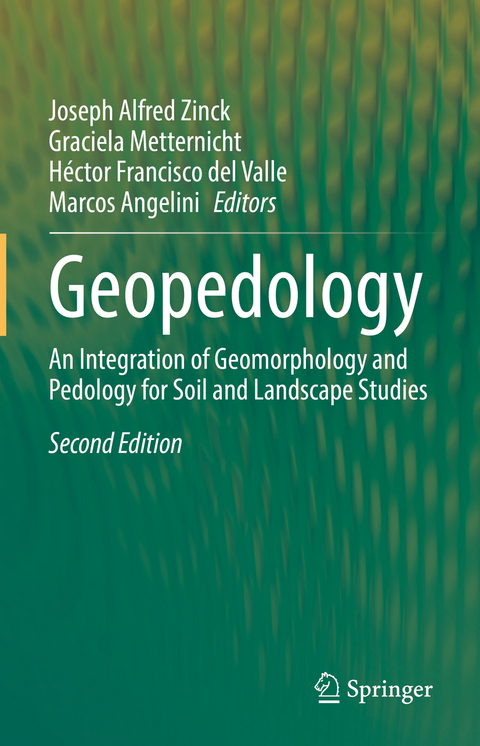
Geopedology
Springer International Publishing (Verlag)
978-3-031-20666-5 (ISBN)
This updated and revised second edition brings geopedology issues into the current context. This new edition extends the work on popular topics such as digital soil mapping, GIS and landscape mapping, and it also gives valuable insight with up-to-date theoretical discussions and new application with relevant case studies. This textbook offers a proven approach for reliable mapping of soil-landscape relationships to derive information for policy, planning and management at scales ranging from local to regional. Filled with didactic elements such as case studies, visual aids (maps, charts and figures), questions and answers, the book is of interest to geohazard studies, land use conflict analysis, land use planning, land degradation assessment, and land suitability analysis.
Soil is a vital resource for society at large and an important determinant of the economic status of nations. The intensification of natural disasters and the increased land use competition for food and energy have raised awareness of the relevant role the pedosphere plays in natural and anthropogenic environments. Recent papers and global initiatives show a renewed interest in soil research and its applications for improved planning and management of this fragile and finite resource.
Joseph Alfred Zinck (deceased) was professor emeritus at the University of Twente, Faculty of Geo-Information Science and Earth Observation (ITC), Enschede, The Netherlands. He has previously worked in soil survey and land use planning projects. Graciela Metternicht is Dean of Science at Western Sydney University, Australia. Her research interests are in the fields of environmental management and geospatial technologies. Héctor Francisco del Valle is is professor at the Regional Geomatic Center (CEREGEO), Universidad Autónoma de Entre Rios (UADER), Entre Ríos province, Argentina. He works in applications of soil remote sensing and geomatics to manage environmental risk. He has more than 45 years of experience in Landscape Ecology and Remote Sensing of Soils. Marcos Esteban Angelini is an international consultant at the Global Soil Partnership, Food and Agriculture Organization of the United Nations, and assistant professor at the National University of Luján, Argentina. His main interest is in Digital Soil Mapping applications for sustainable soil management and soil information systems.
In Memoriam.- Preface.- Chapter 1. Introduction.- Part I. Foundations of geopedology.- Chapter 2. Theoretical framework.- Chapter 3. Relations between geomorphology and pedology: brief review.- Chapter 4. The geopedologic approach.- Chapter 5. The pedologic landscape: organisation of the soil material.- Chapter 6. The geomorphic landscape: criteria for classifying geoforms.- Chapter 7. The geomorphic landscape: classification of geoforms.- Chapter 8. The geomorphic landscape: the attributes of geoforms.- Part II. Approaches to soil-landscape patterns analysis.- Chapter 9. Knowledge is power: where Digital Soil Mapping needs geopedology.- Chapter 10. Geodiversity and Geopedology in a logarithmic universe.- Chapter 11. Algorithms for quantitative Pedology.- Chapter 12. Interaction of geological and pedological processes in the genesis of soils with gypsum, northern Patagonia, Argentina.- Chapter 13. Use of soil maps to interpret soil-landform assemblages and soil-landscape evolution.- Part III. Methods and techniques applied to pattern recognition and mapping.- Chapter 14. Digital soil texture maps of Argentina and their relationship soil-forming factors and processes.- Chapter 15. Synergistic use of radar and optical image data for improved land use and land cover assessment: a case study in the north of Entre Rios province (Argentina).- Chapter 16. Landslide susceptibility mapping using supervised learning methods - case study: southwestern Colombia.- Chapter 17. Polygenic vertisols and "hidden" vertisols of the Paraná river basin, Argentina.- Chapter 18. Mapping gilgai micro-relief and its impact on dryland agricultural landscapes using time series of NDVI derived from Sentinel-2 imagery.- Part IV. Applications in land degradation and geohazard studies.- Chapter 19. Gully erosion analysis. Why geopedology matters?.- Chapter 20. Soil erosion assessment and mitigation scenarios based on Geopedology in northwestern Patagonia, Argentina.- Chapter 21. Adequacy of soil information resulting from geopedology-based predictive soil mapping for assessing land degradation: case studies in Thailand and Iran.- Chapter 22. Exploring the contribution of geopedology to the implementation of national frameworks for land degradation neutrality.- Part V. Applications in land use planning and Policy.- Chapter 23. Geo-pedological approach for land use planning: case studies from India.- Chapter 24. Geopedologic information, foundation for soil conservation: Land evaluation, land use allocation and associated conservation practices.- Chapter 25. The relevance of geopedology for policy making and soil security.- Chapter 26. Significance of land cover change for soil regulating ecosystem services using Maine's Climate Action Plan as a case study.- Chapter 27. Upscaling the integrated Terroir zoning through Digital Soil Mapping disaggregation: a case study in the designation of origin Campo de Borja.- Part VI. Synthesis.- Chapter 28. Concluding remarks and outlook.
| Erscheinungsdatum | 01.02.2023 |
|---|---|
| Zusatzinfo | XIV, 582 p. 1 illus. |
| Verlagsort | Cham |
| Sprache | englisch |
| Maße | 155 x 235 mm |
| Gewicht | 1144 g |
| Themenwelt | Mathematik / Informatik ► Informatik |
| Naturwissenschaften ► Geowissenschaften ► Geologie | |
| Weitere Fachgebiete ► Land- / Forstwirtschaft / Fischerei | |
| Schlagworte | Environmental Management • geomorphology • Landscape and regional planning • Remote Sensing • Soil science and conservation |
| ISBN-10 | 3-031-20666-5 / 3031206665 |
| ISBN-13 | 978-3-031-20666-5 / 9783031206665 |
| Zustand | Neuware |
| Informationen gemäß Produktsicherheitsverordnung (GPSR) | |
| Haben Sie eine Frage zum Produkt? |
aus dem Bereich


